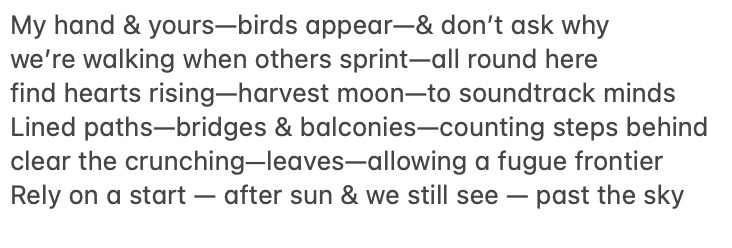HARVEST MOON SESTET
by Ricky Novaes de Oliveira
A walk in the park under the full moon.
I’ve been dabbling in love again, and with that comes rhyme.
I think I may have told you before—rhyming is not my favorite form. To be honest, I find it trite, archaic, cheesy, and predictable; for a while, I felt that the centuries of poetry written in rhyming verse “exhausted” most of the ordinary rhymes out there. Free verse—like jazz music and abstract paintings—has always been more attractive to me in its freedom, association, and verve. In the current moment of commercialized art, I’ve found that for me the most successful rhyming is happening in non-English writing and in concise songwriting. Kendrick Lamar has more rhymes than I could ever hope to aspire to—and that’s fine with me. But rhyme is a good constraint to practice with, and I guess I am trying to become a “Master of Fine Arts” or something hopefully less pretentious than that.
After a nice walk through San Diego’s Balboa Park, I wrote a six-line poem following a rhyme scheme: ABACBA. It was an in-the-moment poem, and I thought of the playful rhymes and meaningful punctuation that Emily Dickinson often employed.
“Harvest moon sestet” version one went like this:
Do you recognize the song I’m alluding to in the first line? This version of the poem was fine, and I could have sent it this morning to you, but I didn’t feel like it was enough. The full moon was on my mind (and above) as I wrote, but my poem didn’t feel full enough, the rhymes not capturing the rhythm I felt.
In typical Ricky fashion, I doubled down—made it complex—tried to challenge myself in hopes of finding a surer shape. Version two of the poem keeps the initial idea and the same constraints (six lines, rhyme scheme), but I tried to inject even more rhyming. Rather than only look at the end-rhymes (the last word of each line) I tried to restructure the poem to also have the first word rhyme, too. In a sense, the rhyme scheme is A-A/B-B/C-C/C-C/B-B/A-A. If that poetic notation makes no sense, think of it like a circle: the first three lines mirror the last three lines. Here it is again:
With two versions—really, two different poems—on my hands, I came to realize that there is perhaps a third. If you read looking for rhyme, you can also read the second version like this:
My why
we’re here
Find minds
lined behind
Clear frontier
rely sky
Though I have often distanced myself from rhyme in poetry, I am starting to see how rhyme offers another way of understanding. The little moments of connection can structure a disparate whole, and trusting the cycles around us (day and night, Earth and moon, love and language) can help to light the way.
Finicky, Ricky





